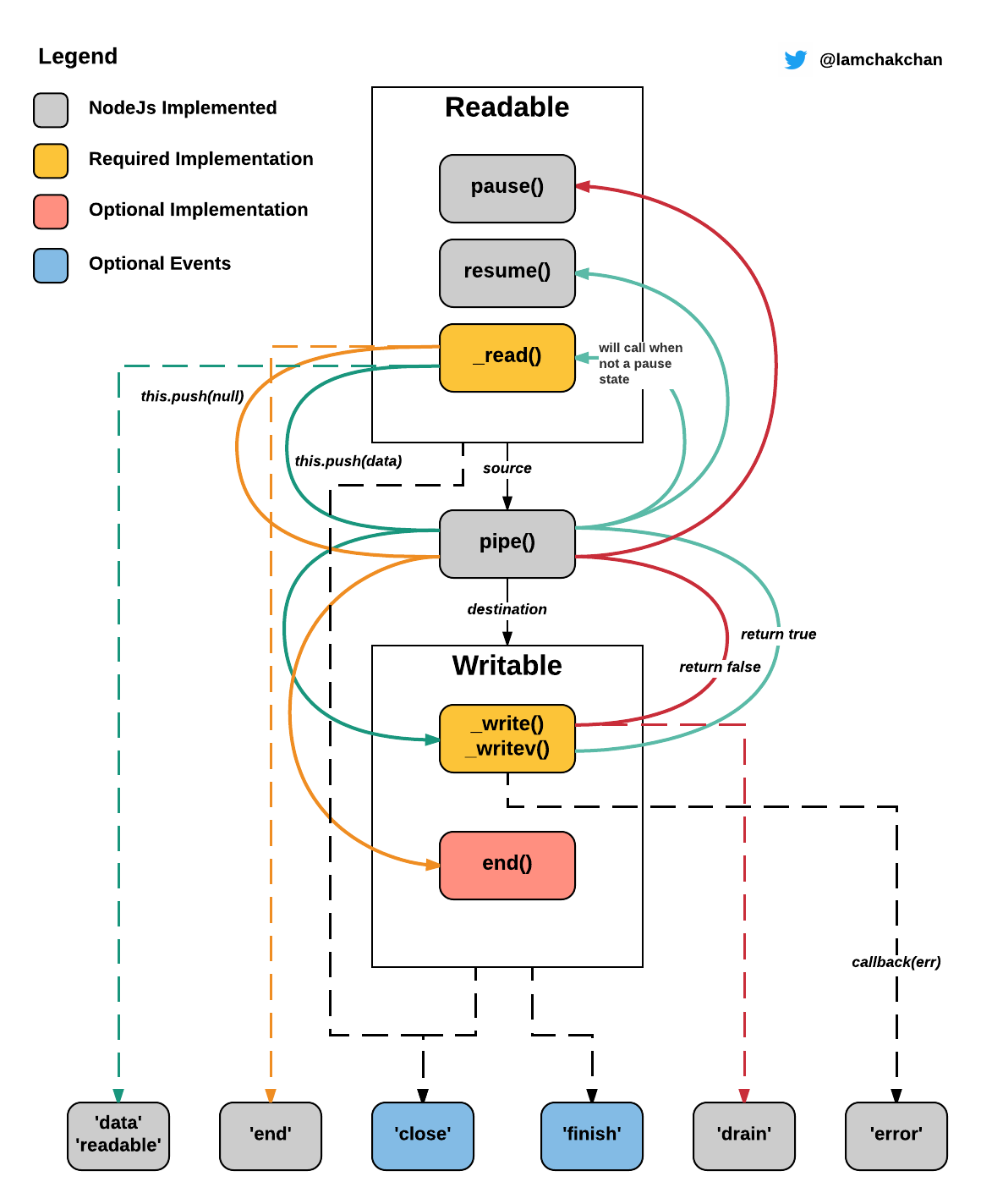本文节选自 Node.js CheatSheet | Node.js 语法基础、框架使用与实践技巧,也可以阅读 JavaScript CheatSheet 或者 现代 Web 开发基础与工程实践 了解更多 JavaScript/Node.js 的实际应用。
Stream 是 Node.js 中的基础概念,类似于 EventEmitter,专注于 IO 管道中事件驱动的数据处理方式;类比于数组或者映射,Stream 也是数据的集合,只不过其代表了不一定正在内存中的数据。。Node.js 的 Stream 分为以下类型:
- Readable Stream: 可读流,数据的产生者,譬如 process.stdin
- Writable Stream: 可写流,数据的消费者,譬如 process.stdout 或者 process.stderr
- Duplex Stream: 双向流,即可读也可写
- Transform Stream: 转化流,数据的转化者
Stream 本身提供了一套接口规范,很多 Node.js 中的内建模块都遵循了该规范,譬如著名的 fs 模块,即是使用 Stream 接口来进行文件读写;同样的,每个 HTTP 请求是可读流,而 HTTP 响应则是可写流。
Readable Stream
const stream = require('stream');
const fs = require('fs');
const readableStream = fs.createReadStream(process.argv[2], {
encoding: 'utf8'
});
// 手动设置流数据编码
// readableStream.setEncoding('utf8');
let wordCount = 0;
readableStream.on('data', function(data) {
wordCount += data.split(/\s{1,}/).length;
});
readableStream.on('end', function() {
// Don't count the end of the file.
console.log('%d %s', --wordCount, process.argv[2]);
});当我们创建某个可读流时,其还并未开始进行数据流动;添加了 data 的事件监听器,它才会变成流动态的。在这之后,它就会读取一小块数据,然后传到我们的回调函数里面。 data 事件的触发频次同样是由实现者决定,譬如在进行文件读取时,可能每行都会触发一次;而在 HTTP 请求处理时,可能数 KB 的数据才会触发一次。可以参考 nodejs/readable-stream/_stream_readable 中的相关实现,发现 on 函数会触发 resume 方法,该方法又会调用 flow 函数进行流读取:
// function on
if (ev === 'data') {
// Start flowing on next tick if stream isn't explicitly paused
if (this._readableState.flowing !== false) this.resume();
}
...
// function flow
while (state.flowing && stream.read() !== null) {}我们还可以监听 readable 事件,然后手动地进行数据读取:
let data = '';
let chunk;
readableStream.on('readable', function() {
while ((chunk = readableStream.read()) != null) {
data += chunk;
}
});
readableStream.on('end', function() {
console.log(data);
});Readable Stream 还包括如下常用的方法:
- Readable.pause(): 这个方法会暂停流的流动。换句话说就是它不会再触发 data 事件。
- Readable.resume(): 这个方法和上面的相反,会让暂停流恢复流动。
- Readable.unpipe(): 这个方法会把目的地移除。如果有参数传入,它会让可读流停止流向某个特定的目的地,否则,它会移除所有目的地。
在日常开发中,我们可以用 stream-wormhole 来模拟消耗可读流:
sendToWormhole(readStream, true);Writable Stream
readableStream.on('data', function(chunk) {
writableStream.write(chunk);
});
writableStream.end();当 end() 被调用时,所有数据会被写入,然后流会触发一个 finish 事件。注意在调用 end() 之后,你就不能再往可写流中写入数据了。
const { Writable } = require('stream');
const outStream = new Writable({
write(chunk, encoding, callback) {
console.log(chunk.toString());
callback();
}
});
process.stdin.pipe(outStream);Writable Stream 中同样包含一些与 Readable Stream 相关的重要事件:
- error: 在写入或链接发生错误时触发
- pipe: 当可读流链接到可写流时,这个事件会触发
- unpipe: 在可读流调用 unpipe 时会触发
Pipe | 管道
const fs = require('fs');
const inputFile = fs.createReadStream('REALLY_BIG_FILE.x');
const outputFile = fs.createWriteStream('REALLY_BIG_FILE_DEST.x');
// 当建立管道时,才发生了流的流动
inputFile.pipe(outputFile);多个管道顺序调用,即是构建了链接(Chaining):
const fs = require('fs');
const zlib = require('zlib');
fs.createReadStream('input.txt.gz')
.pipe(zlib.createGunzip())
.pipe(fs.createWriteStream('output.txt'));管道也常用于 Web 服务器中的文件处理,以 Egg.js 中的应用为例,我们可以从 Context 中获取到文件流并将其传入到可写文件流中:
? 完整代码参考 Backend Boilerplate/egg
const awaitWriteStream = require('await-stream-ready').write;
const sendToWormhole = require('stream-wormhole');
...
const stream = await ctx.getFileStream();
const filename =
md5(stream.filename) + path.extname(stream.filename).toLocaleLowerCase();
//文件生成绝对路径
const target = path.join(this.config.baseDir, 'app/public/uploads', filename);
//生成一个文件写入文件流
const writeStream = fs.createWriteStream(target);
try {
//异步把文件流写入
await awaitWriteStream(stream.pipe(writeStream));
} catch (err) {
//如果出现错误,关闭管道
await sendToWormhole(stream);
throw err;
}
...参照分布式系统导论,可知在典型的流处理场景中,我们不可以避免地要处理所谓的背压(Backpressure)问题。无论是 Writable Stream 还是 Readable Stream,实际上都是将数据存储在内部的 Buffer 中,可以通过 writable.writableBuffer 或者 readable.readableBuffer 来读取。当要处理的数据存储超过了 highWaterMark 或者当前写入流处于繁忙状态时,write 函数都会返回 false。pipe 函数即会自动地帮我们启用背压机制:
当 Node.js 的流机制监测到 write 函数返回了 false,背压系统会自动介入;其会暂停当前 Readable Stream 的数据传递操作,直到消费者准备完毕。
+===============+
| Your_Data |
+=======+=======+
|
+-------v-----------+ +-------------------+ +=================+
| Readable Stream | | Writable Stream +---------> .write(chunk) |
+-------+-----------+ +---------^---------+ +=======+=========+
| | |
| +======================+ | +------------------v---------+
+-----> .pipe(destination) >---+ | Is this chunk too big? |
+==^=======^========^==+ | Is the queue busy? |
^ ^ ^ +----------+-------------+---+
| | | | |
| | | > if (!chunk) | |
^ | | emit .end(); | |
^ ^ | > else | |
| ^ | emit .write(); +---v---+ +---v---+
| | ^----^-----------------< No | | Yes |
^ | +-------+ +---v---+
^ | |
| ^ emit .pause(); +=================+ |
| ^---^---------------------+ return false; <-----+---+
| +=================+ |
| |
^ when queue is empty +============+ |
^---^-----------------^---< Buffering | |
| |============| |
+> emit .drain(); | <Buffer> | |
+> emit .resume(); +------------+ |
| <Buffer> | |
+------------+ add chunk to queue |
| <--^-------------------<
+============+Duplex Stream
Duplex Stream 可以看做读写流的聚合体,其包含了相互独立、拥有独立内部缓存的两个读写流, 读取与写入操作也可以异步进行:
Duplex Stream
------------------|
Read <----- External Source
You ------------------|
Write -----> External Sink
------------------|我们可以使用 Duplex 模拟简单的套接字操作:
const { Duplex } = require('stream');
class Duplexer extends Duplex {
constructor(props) {
super(props);
this.data = [];
}
_read(size) {
const chunk = this.data.shift();
if (chunk == 'stop') {
this.push(null);
} else {
if (chunk) {
this.push(chunk);
}
}
}
_write(chunk, encoding, cb) {
this.data.push(chunk);
cb();
}
}
const d = new Duplexer({ allowHalfOpen: true });
d.on('data', function(chunk) {
console.log('read: ', chunk.toString());
});
d.on('readable', function() {
console.log('readable');
});
d.on('end', function() {
console.log('Message Complete');
});
d.write('....');在开发中我们也经常需要直接将某个可读流输出到可写流中,此时也可以在其中引入 PassThrough,以方便进行额外地监听:
const { PassThrough } = require('stream');
const fs = require('fs');
const duplexStream = new PassThrough();
// can be piped from reaable stream
fs.createReadStream('tmp.md').pipe(duplexStream);
// can pipe to writable stream
duplexStream.pipe(process.stdout);
// 监听数据,这里直接输出的是 Buffer<Buffer 60 60 ... >
duplexStream.on('data', console.log);Transform Stream
Transform Stream 则是实现了 _transform 方法的 Duplex Stream,其在兼具读写功能的同时,还可以对流进行转换:
Transform Stream
--------------|--------------
You Write ----> ----> Read You
--------------|--------------这里我们实现简单的 Base64 编码器:
const util = require('util');
const Transform = require('stream').Transform;
function Base64Encoder(options) {
Transform.call(this, options);
}
util.inherits(Base64Encoder, Transform);
Base64Encoder.prototype._transform = function(data, encoding, callback) {
callback(null, data.toString('base64'));
};
process.stdin.pipe(new Base64Encoder()).pipe(process.stdout);


**粗体** _斜体_ [链接](http://example.com) `代码` - 列表 > 引用。你还可以使用@来通知其他用户。